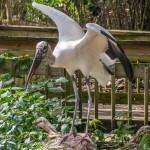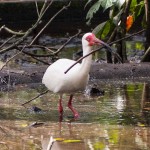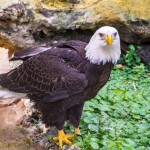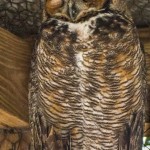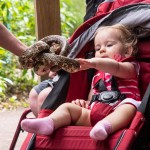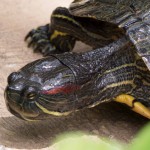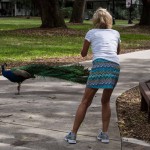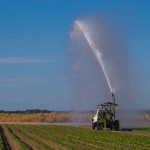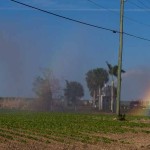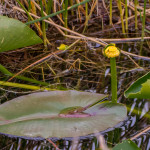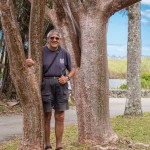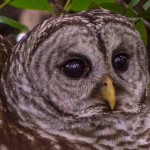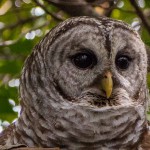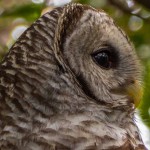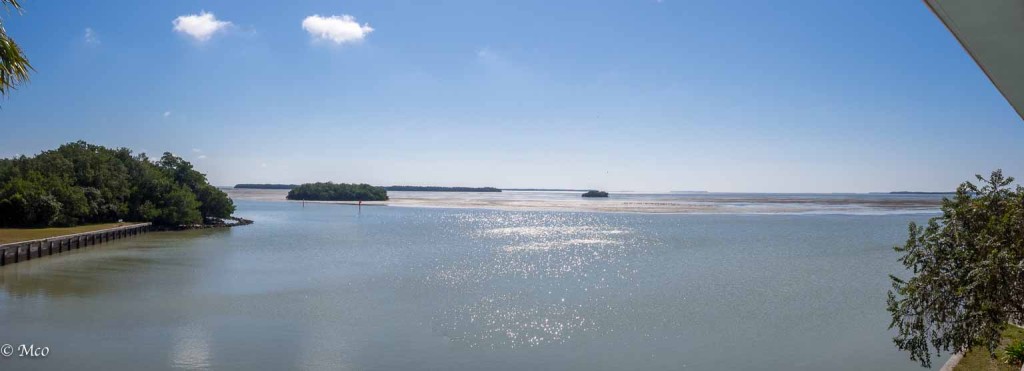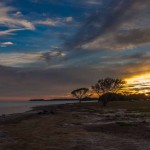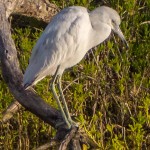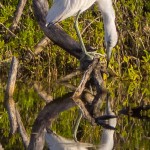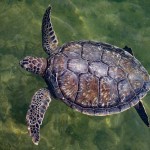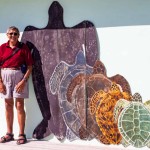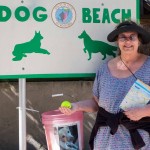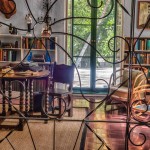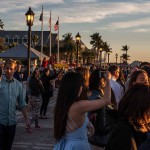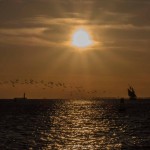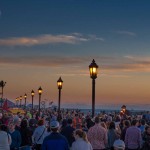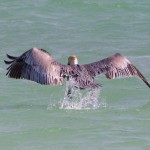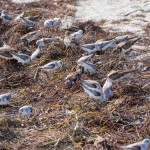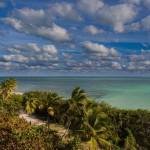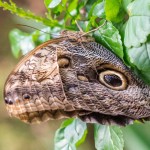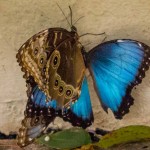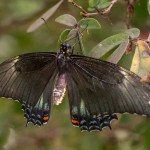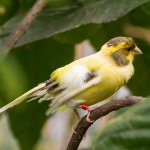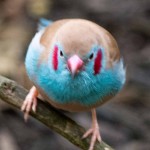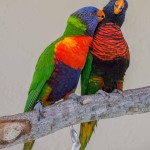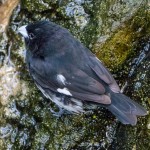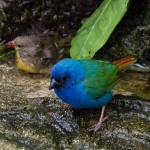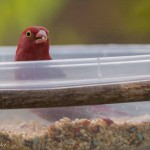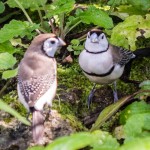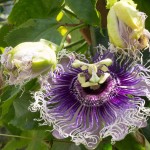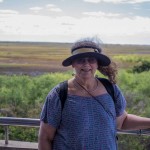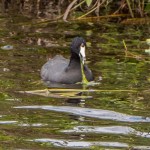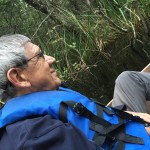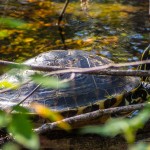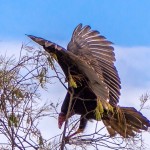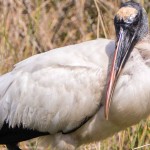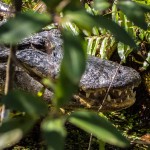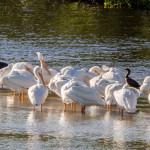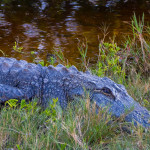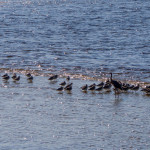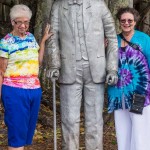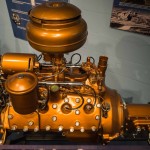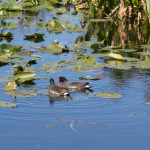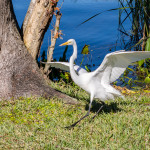

Flamingo Gardens Wildlife Sanctuary
 Hundreds of thousands of American Flamingos used to visit the coastal areas of Florida in the 1800s. They were eradicated completely from the area due to egg and feather hunting over the last century. However, they were sighted again a few years ago in the Everglades National Park at a stormwater water treatment facility. They are now returning regularly, however due to the popularity of the bird with birdwatchers, the National Park Service closed the area to the general public and handed it over to the Audubon Society to control access. They run trips to the area, 147 Flamingos were counted in 2014 but only 8 in 2015. It’s still not known whether the Flamingos began life as wild birds or are escapees from captivity. The Audubon trips are highly oversubscribed so we weren’t able to join one.
Hundreds of thousands of American Flamingos used to visit the coastal areas of Florida in the 1800s. They were eradicated completely from the area due to egg and feather hunting over the last century. However, they were sighted again a few years ago in the Everglades National Park at a stormwater water treatment facility. They are now returning regularly, however due to the popularity of the bird with birdwatchers, the National Park Service closed the area to the general public and handed it over to the Audubon Society to control access. They run trips to the area, 147 Flamingos were counted in 2014 but only 8 in 2015. It’s still not known whether the Flamingos began life as wild birds or are escapees from captivity. The Audubon trips are highly oversubscribed so we weren’t able to join one.
So, there were no Flamingos at the Everglades Flamingo Park where we stayed a few days. However we found a Wildlife Sanctuary in Davie, Florida that provides a safe habitat for many birds and some animals that had been damaged or rescued from other less hospitable facilities. There were also beautiful gardens, many exotic varieties of trees shrubs and flowers. We stayed almost a whole day at the Sanctuary with our ‘snowbird’ friends Jeff and Stacey Smith. There were plenty of Flamingos there, as well as some other beautiful species, as you will see below.
Click on any thumbnail below to see full-size gallery.
- American Flamingo
- Duet
- A dispute
- Roseate Spoonbill
- Wood Stork
- White Pelican (rude variety)
- Brown Pelican
- White Ibis
- White Heron
- Black Crowned Night Heron
- Green Heron
- Tree huggers
- Night Heron (immature)
- Wood Duck
- Bald Eagle
- Golden Eagle
- Osprey
- Harris’ Hawk
- Crested Caracara
- Horned Owl
- Barred Owl
- Barn Owl
- Eastern Screech Owl (tiny)
- Really… it won’t bite?
- Nice…
- Want a date?
- Two peacocks?
- Orchid
- Colin, Stacey, Cheryl, and Jeff
Thank you Stacey for your Fighting Flamingo Movie!
Click on map below to see larger version
Flamingo Wildlife Sanctuary, Davie, Florida

 I’ve been trying to get a decent Pileated Woodpecker photo for over 10 years. One visits us regularly at home, poses while I get my camera, then flies off singing the haha ha Ha ha woody woodpecker song just when I’m ready to shoot. Very frustrating.
I’ve been trying to get a decent Pileated Woodpecker photo for over 10 years. One visits us regularly at home, poses while I get my camera, then flies off singing the haha ha Ha ha woody woodpecker song just when I’m ready to shoot. Very frustrating.
 I’ve been stalking one at the campground in Long Pine Key, Everglades NP for a couple of days. He’s pretty nervous, has a sense of when the camera is ready and takes off to a distant tree. However, early on our last morning, I heard his knocking close to our campsite coming from close to the ground. I was finally able to creep up on him and snapped him through the ‘jungle’ foliage. I like the framing effect caused by pushing my lens through the undergrowth. Has that ‘stalking’ look. However, as he moved up the dead tree, I was able to get a few more shots before he saw me and flew off.
I’ve been stalking one at the campground in Long Pine Key, Everglades NP for a couple of days. He’s pretty nervous, has a sense of when the camera is ready and takes off to a distant tree. However, early on our last morning, I heard his knocking close to our campsite coming from close to the ground. I was finally able to creep up on him and snapped him through the ‘jungle’ foliage. I like the framing effect caused by pushing my lens through the undergrowth. Has that ‘stalking’ look. However, as he moved up the dead tree, I was able to get a few more shots before he saw me and flew off.
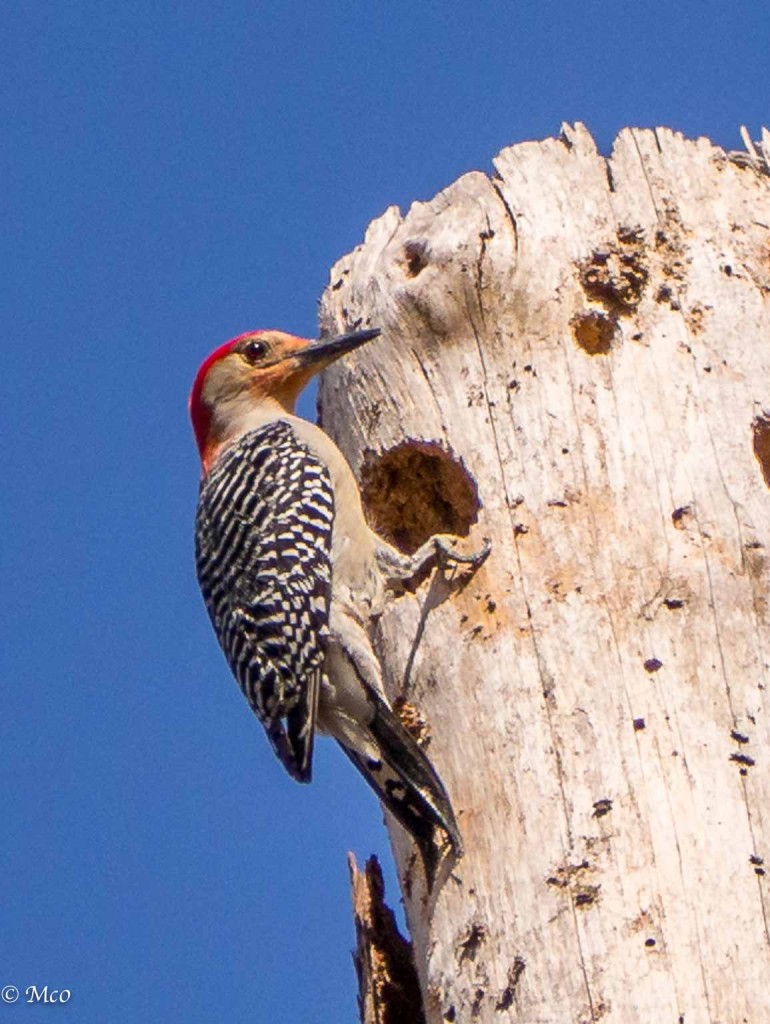 Addendum: a week later I found a Red-bellied woodpecker at Clearwater Lake, Ocala National Forest, also willing to be photographed so I added three more images below.
Addendum: a week later I found a Red-bellied woodpecker at Clearwater Lake, Ocala National Forest, also willing to be photographed so I added three more images below.
Click on any thumbnail below to see full-size gallery.
- First clear view
- Home at last
- Red-bellied woodpecker
Click on map below to see larger version
Long Pine Key Campground, Everglades National Park

The Everglades
The Everglades is a vast tropical wetlands area stretching from Orlando in the North to the Southern tip of mainland Florida. The National Park covers only the lower third of the area. We visited at the end of Florida’s ‘Winter’ which is the dry season when a lot of the wetlands dries up and consequently wildlife becomes highly concentrated in the remaining areas with water. This makes it one of the best places in the world to observe the animals and birds that make this their home. Unfortunately for us this year, the winter was extremely wet so the concentration of wildlife was much less than normal. Although there is certainly no shortage of water in Southern Florida there is a constant struggle to find a balance between the needs of farming, urban development and the preservation of this unique and diverse environment.
Most of the water feeding the area in the National Park flows South over vast sawgrass prairies during the wet season from urban and farming areas starting as far North as Orlando. Many previous attempts to manage the water resources have had damaging effects to the area covered by the Park but it seems that all parties involved are now more aware of each others needs and there is hope that the area will be preserved.
We entered the Park after driving through the intensive crop production area near Homestead and saw multitudes of migrant workers in the fields and were surprised by large areas of budget housing, some in gated communities, provided for them. The sunshine through the irrigation spray caused some great rainbow effects (see below). We split our stay between two campgrounds, Long Pine Key to the North and Flamingo to the South.  Our stay in Flamingo was cut short due to the early crop of mosquitos which had invaded as a consequence of the wet Winter and early Spring. Our new weapon against these obnoxious insects (a ‘Jolt’ portable bug zapper) was effective but the volume of insects during the dawn and dusk hours eventually persuaded us to move back North to Long Pine Key.
Our stay in Flamingo was cut short due to the early crop of mosquitos which had invaded as a consequence of the wet Winter and early Spring. Our new weapon against these obnoxious insects (a ‘Jolt’ portable bug zapper) was effective but the volume of insects during the dawn and dusk hours eventually persuaded us to move back North to Long Pine Key.
While in Flamingo we took two boat rides, one out into Florida Bay and the other inland. We also took advantage of the many boardwalk trails into the areas where water remains in the Winter and provides sustenance for animal and birdlife in addition to the Mangrove, Cypress, and Mahogany trees.
Click on any thumbnail below to see full-size images of irrigation ‘rainbows’
- Crop irrigation near Park Entrance
- Rainbow through spray
Long Pine Key
Long Pine Key campground is situated in a forest of beautiful tall pine trees by a small lake. Campsites are well separated and even though the facilities are sparse at present (restrooms being rebuilt, no power at sites), this didn’t bother us in our Roadtrek which is pretty self-contained. We saw and heard quite a bit of birdlife and enjoyed the quiet (at least during the week). Cheryl was happy to find that our antenna booster put us just in range of a cell connection that provided a workable Internet connection. It was a great location for easy access to Royal Palm trails, the Nike Missile Site and the Paheyokee Overlook trails (see below).
Royal Palms
 Royal Palms has a Visitor Center and has access to the Anhinga Trail boardwalk (the most beautiful in the Park in our opinion) and the Gumbo Limbo trail through dense jungle. The parking lot for Royal Palms had an unusual sign that we hadn’t seen before. It was the warning to visitors to use the provided blue tarps as covers on cars. Apparently, the vultures love to eat the rubber. Cheryl theorized it was the taste of high speed smashed bugs on the windshield wipers and they seem to like window seals also. We stayed away from the times of day when they invaded.
Royal Palms has a Visitor Center and has access to the Anhinga Trail boardwalk (the most beautiful in the Park in our opinion) and the Gumbo Limbo trail through dense jungle. The parking lot for Royal Palms had an unusual sign that we hadn’t seen before. It was the warning to visitors to use the provided blue tarps as covers on cars. Apparently, the vultures love to eat the rubber. Cheryl theorized it was the taste of high speed smashed bugs on the windshield wipers and they seem to like window seals also. We stayed away from the times of day when they invaded.
There was much to see from the Anhinga Boardwalk and Colin enjoyed the Gumbo Limbo trail, particularly the trees which are also named ‘Tourist Tree’ because of their red peeling bark. I particularly appreciated Cheryl’s sharp eyes spotting the Purple Gallinule which gave us such fun watching him use his big feet walk over the lillies.
Click on any thumbnail below to see full-size gallery
- Red-Shouldered Hawk
- Snowy Egret ‘Hat Feathers’
- Anhinga Wing Drying
- Bromeliad Air Plant
- Water Lilies in bloom
- Snowy Egret taking off
- Dragonfly
- Anhinga
- Anhinga
- Anhinga
- Purple Gallinule
- Big Foot
- Walks on Lillies
- Strong Legs
- Turtle Family
- Anhinga Trail Boardwalk
- Alligator
- Colin next to a Gumbo Limbo tree at the start of the Gumbo Limbo trail
- Warning at Royal Palms
- No kidding
- Waiting…
Nike Missile Site
 Hidden in the Park is the Nike Missile Site. This was built in response to the Cuban Missile crisis to add defensive capability against aircraft invasion from the South.
Hidden in the Park is the Nike Missile Site. This was built in response to the Cuban Missile crisis to add defensive capability against aircraft invasion from the South.  Nike-Ajax and Nike Hercules Missiles were assembled and deployed at three sites in the Park (Nike the Greek Winged Godess of Victory not the Sneaker manufacturer). The Park Service organizes daily tours and our volunteer guide did a great job of setting the scene for the deployment and giving a sense of what it was like to man these sites in those days.
Nike-Ajax and Nike Hercules Missiles were assembled and deployed at three sites in the Park (Nike the Greek Winged Godess of Victory not the Sneaker manufacturer). The Park Service organizes daily tours and our volunteer guide did a great job of setting the scene for the deployment and giving a sense of what it was like to man these sites in those days.
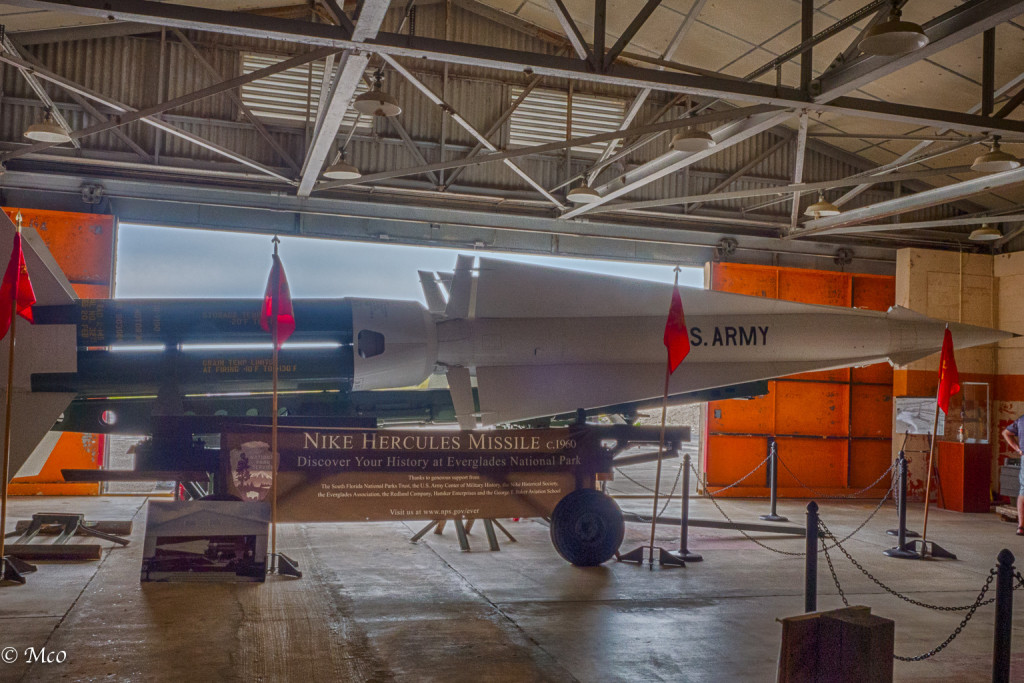
Payhayokee Overlook
We stopped here on our way to Flamingo and followed the boardwalk to a Mangrove Hammock where we found a Barred Owl surveying his territory. After we had moved on a few hundred yards we heard a great racket going on between a crow and the owl who had move into the depths of the thicket. Looking carefully into the trees we saw that in fact there was a pair of owls, presumably nesting with either eggs or chicks. This seemed to be the attraction for the crow.  After a long argument, the owl finally took a run at the crow and chased him off. He then settled into the tree next to his mate and gave us a demonstration of the many faces an owl can make. It was very dark but I was able to capture some of his magnificent expressions.
After a long argument, the owl finally took a run at the crow and chased him off. He then settled into the tree next to his mate and gave us a demonstration of the many faces an owl can make. It was very dark but I was able to capture some of his magnificent expressions.
Click on any thumbnail below to see full-size gallery
- Defending eggs/chicks
- Sharp Talons
- Pair nesting
- Barred Owl on duty
Flamingo
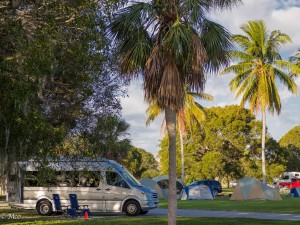 Flamingo is the end of the road from the Eastern Everglades NP. The only way on to Everglades City is by boat out to the Gulf or by canoe / kayak (week long journey). We decided against the trip and took two guided boat trips, one out into the Floriday Bay and the other through a canal to the internal waterways. Flamingo has a Visitor Center and Cafe, used to have a Motel which was destroyed by Hurricanes Katrina and Edna in 2005. The campground is on the shores of the Bay and our site was in an open area. We enjoyed relaxing in the warm breeze during the afternoons but had to retire inside the van at dusk to fight the mosquitoes that had somehow made their way in. We experienced some pretty sunsets while swatting the bugs.
Flamingo is the end of the road from the Eastern Everglades NP. The only way on to Everglades City is by boat out to the Gulf or by canoe / kayak (week long journey). We decided against the trip and took two guided boat trips, one out into the Floriday Bay and the other through a canal to the internal waterways. Flamingo has a Visitor Center and Cafe, used to have a Motel which was destroyed by Hurricanes Katrina and Edna in 2005. The campground is on the shores of the Bay and our site was in an open area. We enjoyed relaxing in the warm breeze during the afternoons but had to retire inside the van at dusk to fight the mosquitoes that had somehow made their way in. We experienced some pretty sunsets while swatting the bugs.
Click on any thumbnail below to see full-size gallery
- Sunset over Florida Bay
- Sunset over Florida Bay
- Sunset over Florida Bay
- Sunset over Flamingo Campground
- Sunset over Flamingo Campground
- Sunset over Flamingo Campground
- Campsite at Flamingo by Floriday Bay
- Florida Bay from the Flamingo Visitor Center
Inland fron Flamingo
 We took a two hour boat trip through the Buttonwood Canal to Coot Lake and on to Whitewater Lake where tidal salt waters from the Gulf mix with fresh water from the Everglades and were fortunate to find a Green Heron as well as a Great White and a Swallow-Tailed Kite in the distance. We came across some Manchineel trees which are poisonous to the touch and were used by native Indians to tip their arrows. (It was this poison on an arrow that finally killed the famous Spanish explorer Juan Ponce de Leon). We were hoping the kayakers we passed were well informed about dangers. We saw some crocodiles (tolerant to salt water unlike Alligators) and noticed the dark brown water caused by tannin from decomposing Mangrove leaves.
We took a two hour boat trip through the Buttonwood Canal to Coot Lake and on to Whitewater Lake where tidal salt waters from the Gulf mix with fresh water from the Everglades and were fortunate to find a Green Heron as well as a Great White and a Swallow-Tailed Kite in the distance. We came across some Manchineel trees which are poisonous to the touch and were used by native Indians to tip their arrows. (It was this poison on an arrow that finally killed the famous Spanish explorer Juan Ponce de Leon). We were hoping the kayakers we passed were well informed about dangers. We saw some crocodiles (tolerant to salt water unlike Alligators) and noticed the dark brown water caused by tannin from decomposing Mangrove leaves.
Click on any thumbnail below to see full-size gallery
- Sunrise at Eco Pond
- Great White Heron
- Looking at his refection
- Green Heron…
- …on Mangrove Roots
- Swallow-Tailed Kite
- Manchineel Tree (poisonous)
- Crocodile (not alligator)
Florida Bay
We took a one and a half hour boat trip on a powered pontoon boat out into the expanse of water stretching from Southern Mainland Florida to the Keys. Like parts of the Chesapeake Bay, although broad, the area is mainly shallow, many areas only 2 -3 feet deep. The tidal range is only about 1 – 2 feet and our tour guide claimed it was possible to walk from the mainland to Key West across the Bay. The birds take to the the sand spits exposed at low tide and gorge on shellfish. We saw many white pelicans, cormorants, and plovers gathering to partake of the Smorgasbord of seafood. We also found a familiar sight to Chesapeake Bay sailors, an Osprey nest with three chicks on top of a channel marker.
Click on any thumbnail below to see full-size gallery
- Sandbar Feeding Ground
- White Pelicans, Plovers …
- Cormorant hangout
- Osprey pair with chicks
- On lookout
- Florida Bay boat trip
Click on map below to see larger version
Flamingo Campground, Everglades National Park

It was high on my to-do list, to understand how rescued turtles are treated and returned to the wild when possible.  At this turtle hospital, the veterinarians have a full surgery suite, research area, and patient recovery system that is very impressive. Previous to being a hospital, the building was a motel. Each of the rooms and swimming pool have been turned into recuperation staging areas. Most of the ailments have to do with power boats digging holes into the top of the turtle’s shells with their propellors and intestinal bloating problems due to consuming plastics, hooks, and other garbage from the sea. For the skid marks left on the shells, the doctors use antibiotics and epoxy to keep the shell from further infection. The shell is a living thing made out of the same material as our finger nails (cartilage), therefore, total replacement is not possible since the shell should continue to grow as the turtle ages. Turtles which are unable to make a full recovery become permanent residents of this hospital or sent to other facilities as teaching ambassadors. The intestinal bloating problem is sometimes so bad, surgery has to be done, otherwise, Beano and laxative treatments can help with more moderate problems. The way the docs know a bloating problem? The turtles are called, Bubble Butts, because the whole shell is stretched and raised in a non-conforming way, bubbling over the lower part of the shell. The air affects the buoyancy so much that the turtle cannot dive for food and starves to death. A terrible problem to see. The lucky turtles brought to the hospital via emergency calls and ambulance transport very often recover. The Keys’ area is a spawning ground and nursery for turtles, so the hospital is well situated geographically to provide aid. Releasing a turtle back to the wild is a cause for great celebration and the public and all those involved with the rescue, treatment and release are invited. http://www.turtlehospital.org
At this turtle hospital, the veterinarians have a full surgery suite, research area, and patient recovery system that is very impressive. Previous to being a hospital, the building was a motel. Each of the rooms and swimming pool have been turned into recuperation staging areas. Most of the ailments have to do with power boats digging holes into the top of the turtle’s shells with their propellors and intestinal bloating problems due to consuming plastics, hooks, and other garbage from the sea. For the skid marks left on the shells, the doctors use antibiotics and epoxy to keep the shell from further infection. The shell is a living thing made out of the same material as our finger nails (cartilage), therefore, total replacement is not possible since the shell should continue to grow as the turtle ages. Turtles which are unable to make a full recovery become permanent residents of this hospital or sent to other facilities as teaching ambassadors. The intestinal bloating problem is sometimes so bad, surgery has to be done, otherwise, Beano and laxative treatments can help with more moderate problems. The way the docs know a bloating problem? The turtles are called, Bubble Butts, because the whole shell is stretched and raised in a non-conforming way, bubbling over the lower part of the shell. The air affects the buoyancy so much that the turtle cannot dive for food and starves to death. A terrible problem to see. The lucky turtles brought to the hospital via emergency calls and ambulance transport very often recover. The Keys’ area is a spawning ground and nursery for turtles, so the hospital is well situated geographically to provide aid. Releasing a turtle back to the wild is a cause for great celebration and the public and all those involved with the rescue, treatment and release are invited. http://www.turtlehospital.org
Click on any thumbnail below to see full size gallery.
- Surgery Suite
- Comparing the turtle sizes to Colin. Largest is Loggerhead, can reach up to 1000 lbs.
Click on map below for larger version
Turtle Hospital on Marathon Key, Florida

The route west from the Florida mainland over the Keys to Key West is an amazing one. Last minute reservations were difficult so we only had three nights booked on Sunshine Key (close to Bahia Honda Key State Park). Warned of traffic problems, we left Ft. Lauderdale in the middle of the night, saw little traffic (or anything else) and arrived at Sunshine Key at 8 a.m. We decided to drive on to Key West in the daylight so began to appreciate the scenery. The Keys were only accessible by boat until the Over-Sea Railroad was built by Henry Flagler starting in 1905 and completed to Key West by 1912. The railroad was devastated by the Labor Day Hurricane of 1935 and, given the state of the economy, a decision was made in 1936 to abandon the railroad in favor of completing the Overseas Highway, using some of the surviving rail bridges, to Key West.
 Several sections of the rail bridges remain today, often used as fishing piers. On Bahia Honda Key, I found a Geodetic Survey point (known as a ‘trig point’ in England) with what looked like a date of 1935 over-stamped with 1936.
Several sections of the rail bridges remain today, often used as fishing piers. On Bahia Honda Key, I found a Geodetic Survey point (known as a ‘trig point’ in England) with what looked like a date of 1935 over-stamped with 1936.  This was likely used post-hurricane to help locate the highway. We spent a full day in Key West followed by a couple of days enjoying the keys and beaches, particularly at Bahia Honda State Park.
This was likely used post-hurricane to help locate the highway. We spent a full day in Key West followed by a couple of days enjoying the keys and beaches, particularly at Bahia Honda State Park.
Key West
Key West is a fun place to spend some time. Lots happening. Here are two things that surprised us:. 1) ‘Cuban Chickens’ roam the streets without a care. No-one owns them, and apparently they are descendants of chickens brought to Key West over 200 years ago, adding to the colorful nature of the city. 2) Mallory Square at sunset is a happening place every night. Well, the sun does set every night. The excitement generated suggests that many visitors hadn’t realized this and were seeing it for the first time. Fun, nevertheless.
- Street Scenes
- Upscale neighborhood
- The ‘Little White House’
- Ready to steal?
- Cuban Chickens
- Ready to eat?
- With babies
- Cheryl found a favorite spot …
- … or two
- Hemmingway’s House
- A Hemmingway Cat
- …and cat shelters
- Boardwalk
- Hitching a ride?
- Pelican feeding time at the fishing dock
- Art Museum in Key West
- Sun Setting at Mallory Square
- Keeping 2 kids warm or under control?
Bahia Honda Key
Bahia Honda State Park Beach must be one of the best in the world. The color contrast between the white sand, the green sea and the blue sky was a joy to experience. We were treated to a diving and fishing display by some local pelicans, two of which decided to work in tandem. We also enjoyed seeing the Plovers run on the beach in unison – they are so much fun to watch! (See the video after the photo gallery, below.) We visited the Key Deer Wildlife Refuge and saw only fleeting glimpses of the tiny (25″ tall) Key Deer until I went to ‘Blue Hole’. After sitting still for ten minutes, a pair of them walked casually by within inches of me.
- Bahia Honda Beach
- Framed
- Water Fun
- Pelican pouch
- Taking off
- Looking
- Fishing in pairs
- Diving
- Synchronised Plover Running
- Rail Bridge section
- Trig Point
- Coexisting?
- Key Deer
Video of the Plovers running on the Bahia Honda beach.
Click below to see larger map.
Mallory Square, Key West.

We spent a day at Butterfly World, well actually 6 hours and 600 photographs! I think Colin took 300 of them in the first 10 minutes. We walked our feet off, but now we can visualize what Eden looked like (if it existed, this is the way we’d have wanted it to look!) What a heavenly place, and to say we were enthusiastic would be quite an understatement. It seems we were in attendance during mating season. The butterflies and the birds seemed to be dancing many a two-step, and sometimes an orgy of 3 or 4!
Butterflies
As we entered the main butterfly exhibit, we were amazed at the exotic birds, flowers, plants, and waterfalls that created the different eco systems for the butterflies from around the world. The staff has a nursery and all butterflies are “grown” locally, and released in the wild to help the butterfly population recover from pesticides, changing climate and habitats. Early on in the exhibit, a butterfly landed on the back of Colin’s t-shirt and stayed with him for an hour or so. We walked from tropical areas to deciduous forests, grinning at all we saw.
Click on thumbnail below to see full-size gallery.
- Owl Butterfly, disguised as a snake!
- This Owl Butterfly loves Colin’s t-shirt
- Magnificent Blue Morpho mating here.
- Many Piano Key males fight over the fluttering female
- One very persistent and strong male wins the mating game
- Malachite butterfly
- Giant Swallowtail
- Magnificent white Tree Nymph
- Mating Tree Nymphs
- Chocolate Pansy
- Tropical
- Tropical
- Rusted Tipped Page
- Archduke
- Plesseni mating couple
Birds
The exotic birds were thrilling to see, the colors magnificent.
Click on thumbnail below to see full-size gallery.
- Gouldian Finch
- Canary, Canary Islands
- Zanzibar Bishop Weaver, Africa
- Western S Africa
- Bathing Ovenbird
- Red-legged Honeycreeper
- Red-checked Cordon-blue, Africa
- Shafttail Finches, Australia
- Shafttail Finch
- Shafttail Finch
- Parrot finches
- Rainbow Lorikeets
- Rainbow Macaw
- Black & White Seedeater, Venezuela
- Society Finch, N America
- Society Finch
- Tricolored Parrot Finch
- Red Billed Firefinch
- Red Billed Firefinch
- Black-faced Dacnis, S America
- Sea Green Parrot Finches
- Sea Green Parrot Finch
- Owl Finches
- Lady Gouldian Finch
- Lady Gouldian Finch (her and him)
- Chinese Painted Quail
Flowers
The butterflies and birds need specific types of plants and flowers to thrive. To insure a healthy population of insects and birds, all of the vines, flowers, shrubs, and trees are grown in the in the Butterfly World nurseries.
Click on thumbnail below to see full-size gallery.
- Passiflora ‘Byron Beauty’ Passifloraceae
Click below to see more detailed map.
Butterfly World, Pompano Beach, Florida

Big Cypress National Preserve was created in 1974 from 720,000 acres of wet cypress forest and grassland. It is not a National Park, the Miccosukee and Seminole Tribes of Florida still live here, Off Road Vehicles are allowed and hunting is permitted in some areas. However, it has the feel of a National Park and has several trails and visitor centers of interest.  We found a campground at Burns Lake which, though ‘primitive’ provided a beautiful setting for our home and travel hub for a week. We were surprised to find alligators so close to people, and also interested to find that some bluebirds, instead of freezing the winter out in Maryland, became snowbirds and traveled to Florida.
We found a campground at Burns Lake which, though ‘primitive’ provided a beautiful setting for our home and travel hub for a week. We were surprised to find alligators so close to people, and also interested to find that some bluebirds, instead of freezing the winter out in Maryland, became snowbirds and traveled to Florida.  While touring in the area, we found the smallest Post Office in the States at Ochopee in the Wildlife Preserve.
While touring in the area, we found the smallest Post Office in the States at Ochopee in the Wildlife Preserve.  Cheryl also managed to find a new friend, ‘Benny’ and provided babysitting services for our new friends Tony and Mona Rothschild.
Cheryl also managed to find a new friend, ‘Benny’ and provided babysitting services for our new friends Tony and Mona Rothschild.
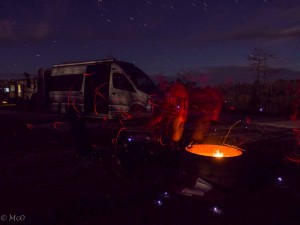 nd is about half the size of a tennis racket, same shape. It can deliver megavolts with the right aim, behaves like the Bug Zappers you are familiar with. Here’s a photo of it in action wielded by Cheryl. It has a red light when activated
nd is about half the size of a tennis racket, same shape. It can deliver megavolts with the right aim, behaves like the Bug Zappers you are familiar with. Here’s a photo of it in action wielded by Cheryl. It has a red light when activatedand the white dots are ‘kills’.
Burns Lake Campground
- Our Roadtrek Van
- Bug Zapping with Zolt!
- Sunset over the lake
- Bluebird becomes snowbird
- Snoozing by the lake
- Watching…
- Short walk through a Panther Reserve Trail (didn’t find any)
Shark Valley Tram Tour
We took a tram tour at the Northern entrance to the Everglades National Park and were introduced to more of the bird and animal life in the area.
- Observation platform
- Pair of Grebes
- Anhinga
- Tricolored Heron
- Anhinga-wing drying
- Anhinga
- Coot
Pole Boat Tour
We felt that a traditional Air Boat Swamp Tour (advertised all over, very noisy) was the last way to see the wildlife in the area so we found a company that ran Pole Boat Tours. A ‘pole boat’ is a flat bottomed punt moved along with a long pole (well known to me with my Cambridge background). It was a very peaceful two hour trip, just the two of us plus Jules our ‘driver’ and I’m sure we were able to see much more and get a better feel for the swamp ambience. Jules claimed the company had researched the boat design in Cambridge so I offered him a few points on his poling technique.
- Our transport
- Osprey
- Anhinga
- Anhinga
- Bromeliads and Moss
- Jules
- Tour Office
Kirby Storter Roadside Park
We loved this park which had a long boardwalk over the swamp (and a good cell signal).
- Mangrove Knees
- Mangrove Knees
- Turtle
- Moon Flower
- Everglades City
More Bird Life
- White Egrets
- Anhinga
- Hawk
- Ibis (juvenile)
- Boat-tailed Grackle
- Cow-bird
- Black Vulture
- Playing well together?
- Wood Stork
- Wood Storks
Click to see location on larger map.

Audubon Sanctuary
Audubon’s Corkscrew Swamp Sanctuary, located about 30 minutes east of Naples, features a 2.5 mile long boardwalk through pine flatwoods, wet prairie, around a marsh, and finally into the largest old growth Bald Cypress forest in North America.  The unusually high water levels for the time of year resulted in the bird population being spread out over a much larger area than usual so opportunities for observing the varied birdlife were reduced. However, the highlight of our walk was seeing a female alligator with babies (each about 6 inches long) under her protection. Food seemed to be plentiful as witnesses by the photos below and we loved the variety of scenery with the light shining through the forest.
The unusually high water levels for the time of year resulted in the bird population being spread out over a much larger area than usual so opportunities for observing the varied birdlife were reduced. However, the highlight of our walk was seeing a female alligator with babies (each about 6 inches long) under her protection. Food seemed to be plentiful as witnesses by the photos below and we loved the variety of scenery with the light shining through the forest.
- Red-Bellied breakfast
- Egret breakfast (crab)
- Ahninga breakfast
- Drying out
- Water moccasin
- Baby Carriage
- Protective grin
- Little blue heron
- Audubon Wildlife Trail
Click on map to see location

Sanibel Island
We made our way to Fort Myers to see our friends from long ago, Elaine Keeler and Sid Rheuban. I worked for Elaine in MRI Education and Testing for Picker International starting in 1986 through 1989. So it had been quite a while since we last saw each other, only keeping up with each others’ lives through Christmas/Chanukah letters. It only took an instant and we were back in the swing of our beautiful relationship. Elaine gave me a wedding shower in 1988 at her home and the pictures are still risqué in 2016. I’ll have to post them in a separate blog, but that’s for another time.
Elaine and Sid were fantastic hosts, playing tour guides for four days. We visited Sanibel Island, via a bridge connected to Fort Myers, and we toured the J. N. “Ding” Darling National Wildlife Refuge. The highlight of the trip was when we observed flocks of pelicans, both white and brown, two Roseate Spoonbills, and many smaller birds gathered for their “Happy Hour” before they roosted for the night in the trees behind these pictures. These birds ordinarily don’t get along and fight for territ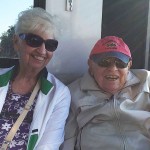 ory while feeding. But here in Sanibel, while wintering in Florida, the birds make a truce and it is rare to find them squawking at one another. The highlight was just seeing the volume of birds in one place! Also watching Sid dance with his three wheel ‘walker’ to stay warm while the sun set and we waited for dinner at the ‘Mucky Duck’ on Captiva (adjoining Sanibel).
ory while feeding. But here in Sanibel, while wintering in Florida, the birds make a truce and it is rare to find them squawking at one another. The highlight was just seeing the volume of birds in one place! Also watching Sid dance with his three wheel ‘walker’ to stay warm while the sun set and we waited for dinner at the ‘Mucky Duck’ on Captiva (adjoining Sanibel).
Click on thumbnail below to see full-size gallery.
- Roseate Spoonbill coming in for landing
- White and Brown Pelicans and Cormorants
- I’m watching you!
- Mangrove Tree Crab
- Elaine and Cheryl
- Elaine and Sid
Fort Myers
 Out to dinner at Doc Fords, which is owned by Randy Wayne White, the author of mysteries based in Sanibel. Fun place, live music, watching the sunset from the deck while dining. Another highlight of our trip was visiting the Thomas Edison and Henry Ford winter homes in Fort Myers. They built their houses next to each other, and shared a workshop where they exchanged ideas. Of course both homes were wired with incandescent light bulbs, electric fans, and many inventions brought to market by Edison. A beautiful setting overlooking the Caloosahatchee River, exquisite gardens, and a very worthwhile place to visit. Thank you Elaine and Sid for sharing your city with us!
Out to dinner at Doc Fords, which is owned by Randy Wayne White, the author of mysteries based in Sanibel. Fun place, live music, watching the sunset from the deck while dining. Another highlight of our trip was visiting the Thomas Edison and Henry Ford winter homes in Fort Myers. They built their houses next to each other, and shared a workshop where they exchanged ideas. Of course both homes were wired with incandescent light bulbs, electric fans, and many inventions brought to market by Edison. A beautiful setting overlooking the Caloosahatchee River, exquisite gardens, and a very worthwhile place to visit. Thank you Elaine and Sid for sharing your city with us!
- Out to dinner at Doc Fords
- Sid, Elaine, and Cheryl
- Sunset from Doc Fords
- Friendly Ibis in Elaine and Sid’s front yard
- Winter home of Tomas Edison, Cypress Tree Garden
- Elaine and Cheryl with Thomas Edison
- Elaine and Sid
- Edison’s Winter Home
- Guest and Secretary’s Apartments
- Dinning Room
- Living Room / Salon
- Original bamboo planted by Edison
- Colin with Henry Ford
- Cheryl with one of Ford’s wives (he had three)
- The Model T
- The first working truck
- The Model T Engine
Click on map to see location

Alternative Routes
 As usual, unless we are short of time, we ask our trusty German GPS to give us some alternative routes to our next destination. This often results in new discoveries and fun mini-adventures. So instead of heading for I75 down the West Coast of Florida we went down the middle and discovered two ‘gems’. The first of these was Eustis, Florida and the Lake Eustis Museum of Art. We found it looking out of the window of the Barnwood BBQ diner. It’s located next to a marshy pool by the side of the lake, populated by many fish and birds. We benefited from a wonderful display by a Snowy Egret.
As usual, unless we are short of time, we ask our trusty German GPS to give us some alternative routes to our next destination. This often results in new discoveries and fun mini-adventures. So instead of heading for I75 down the West Coast of Florida we went down the middle and discovered two ‘gems’. The first of these was Eustis, Florida and the Lake Eustis Museum of Art. We found it looking out of the window of the Barnwood BBQ diner. It’s located next to a marshy pool by the side of the lake, populated by many fish and birds. We benefited from a wonderful display by a Snowy Egret.  The museum contained a display of some neat artwork, paint and sculpture, by Kace Montgomery and Kate Esplen showing sandhill cranes and horses.
The museum contained a display of some neat artwork, paint and sculpture, by Kace Montgomery and Kate Esplen showing sandhill cranes and horses.
 Following this, we drifted into a really quaint town of Mount Dora, which reminded us of Highlands, NC where we found a beautiful lake and relaxed by the lake until we were invaded by a Segway Tour.
Following this, we drifted into a really quaint town of Mount Dora, which reminded us of Highlands, NC where we found a beautiful lake and relaxed by the lake until we were invaded by a Segway Tour.
Click on map to see location








